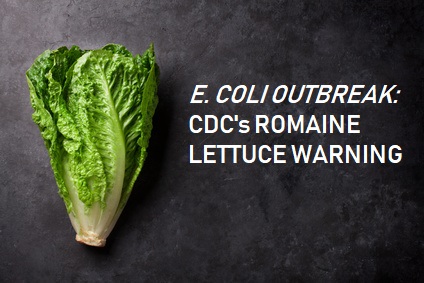The list of people infected with the multistate outbreak of Shiga toxin-producing E. coli O157:H7 is quickly growing. Currently, the CDC is reporting that as of April 19, 2018, 53 people in 16 states have been infected, including 31 people who have been hospitalized and five people who have developed a type of kidney failure called hemolytic uremic syndrome. The CDC, several states, the U.S. Food and Drug Administration, and the U.S. Department of Agriculture’s Food Safety and Inspection Service are still investigating but have indicated that information collected to date indicates that romaine lettuce from the Yuma, Arizona growing region could be contaminated with E. coli O157:H7 and could make people sick.
The CDC has expanded its warning to cover all types of romaine lettuce form the Yuma, Arizona growing region and includes whole heads and hearts of romaine lettuce, in addition to chopped romaine and salads and salad mixes containing romaine. The CDC is giving the following warning:
- Do not buy or eat romaine lettuce at a grocery store or restaurant unless you can confirm it is not from the Yuma, Arizona, growing region.
- Unless the source of the product is known, consumers anywhere in the United States who have any store-bought romaine lettuce at home should not eat it and should throw it away, even if some of it was eaten and no one has gotten sick. Product labels often do not identify growing regions; so, throw out any romaine lettuce if you’re uncertain about where it was grown. This includes whole heads and hearts of romaine, chopped romaine, and salads and salad mixes containing romaine lettuce. If you do not know if the lettuce is romaine, do not eat it and throw it away.
The CDC has also described the signs and symptoms of the illness as follows:
- People usually get sick from Shiga toxin-producing coli(STEC) 2–8 days (average of 3–4 days) after swallowing the germ.
- Most people infected with coli develop diarrhea that can be bloody, severe stomach cramps, and vomiting.
- Most people recover within 1 week.
- Some infections are very mild, but others are severe or even life-threatening.
- Some people with a STEC infection may get a type of kidney failure called hemolytic uremic syndrome (HUS).
- HUS can occur in people of any age but is most common in children younger than 5 years, adults aged 65 years and older, and people with weakened immune systems.
- HUS develops about 7 days after symptoms first appear, when diarrhea is improving.
- Clues that someone is developing HUS include
- decreased frequency of urination,
- feeling very tired, and
- losing pink color in cheeks and inside the lower eyelids.
- People with HUS should be hospitalized because their kidneys may stop working and they may develop other serious problems.
- Most people with HUS recover within a few weeks, but some suffer permanent damage or die.
- coli infection is usually diagnosed by testing a stool sample.
If you have symptoms of an E. coli infection you should seek immediate medical treatment, write down what you ate in the week before you started getting sick, including any romaine lettuce, and report your illness to the health department.
How We Can Help
Attorney Pamela Borgess has successfully represented multiple clients who have sustained serious injury as a result of contaminated food, including lettuce. If you or a loved one has recently been diagnosed with an E. coli infection and would like more information or would like to speak with Attorney Borgess, contact BORGESS LAW, LLC at (567) 455-5955. You can also contact Borgess Law, LLC by submitting an online inquiry. Borgess Law, LLC never charges a fee for an initial consultation.
